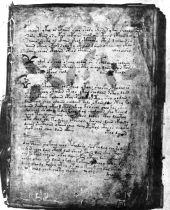
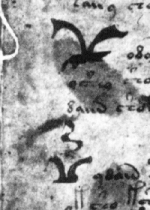
Last edited on 2002-03-02 20:06:09 by stolfi
On page f1r, the first page of the Voynich manuscript (below left), there are two large symbols in red ink (right):


Since the "S"-shaped squiggle above the bottom character is in red ink too, it seems safe to assume that it is part of that character.
These symbols do not occur anywhere else in the manuscript, and in style they are quite distinct from other Voynichese letters, even from the so-called "weirdos". They are also one of only two uses of red ink in the manuscript (the other one being a single paragraph in the astro/cosmo section).
Their size and color suggest that they are quite important. Rene Zandbergen observed that the top one resembles a classical symbol for Aries, but the bottom one has defied interpretation so far.
However, let's turn the page upside down --- so that the binding is on the right side, as in a modern Chinese book:
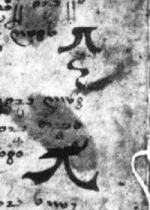
These two symbols now look vaguely similar to Chinese characters. More precisely, to those imitations of them drawn by someone who is illiterate in Chinese, such as one occasionally sees in Western comic books.
Indeed, while those two symbols appear to have been drawn with a quill pen (like the rest of the VMS), it looks as if the scribe tried to imitate the look of brushed characters. (Quill pen strokes generally have uniform width and squarish ends; brush strokes generally have variable width and characteristic flared/hooked/pointed ends.)
Assuming for the moment that those weirdos are indeed badly copied ideographs, what could the original characters be?
I looked for similar shapes in an online Chinese character dictionary, and also asked a Chinese colleague (Siang Wun Song from the University of São Paulo) to have a look. We both got independently the same guesses:
| Top | Bottom |
|---|---|
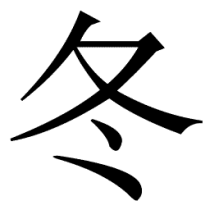
|
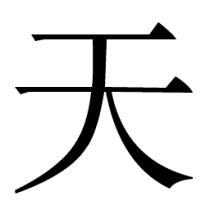
|
| dong1 (tung) | tian1 (tien) |
The similarity may seem non-existent, but the VMS symbols should be compared to the cursive or semi-cursive forms of these characters, and not to the "hand-printed" forms above. In cursive forms of "dong1", the two "quote marks" at the bottom do become a squiggle, and its "head" may shrink to a short and fat stroke. The two strokes of "tian1" may get closer and may fuse into one thick stroke.
The top character "dong1" is a radical meaning "winter". The bottom one, "tian1" has several meanings including "heaven" (as in "Tiananmen", the Gate of Heavenly Peace), "God", and "day".
The combination "dong1 tian1" is a perfectly valid Chinese compound that means "winter" or "winter day".
Other possibilities for the bottom character (suggested also by Claus Anders and Gabriel Landini) are:
However, in "dai4" and "wang1" the vertical stroke should extend above the horizontal line; and in "wu4" the two legs should not join at the top. Moreover, in all these characters the horizontal stroke should be thinner than the legs, whereas the VMS scribe intentionally made it extra thick. So I would rather think that the original was indeed "tien1", with the two strokes rather close together (or fused, as they would be in cursive script); and the scribe misinterpreted them as "one double-width stroke".
In any case, the combinations "dong1 dai4", "dong1 wang1", and "dong1 wu4" don't seem to have any special meaning.
The word "winter" does not seem out of place on a book dealing with astronomy and/or astrology. There may be a connection to the fact that the VMS zodiac starts with Pisces, which contains the winter solstice.
However, those characters may have another meaning. Asked about "Dongtian" and "medicine", Google came up with this:
http://chineseculture.about.com/library/china/ethnic/blsethnic011.htm
The Bai ethnic minority
Of the 1,598,100 Bai people, 80 per cent live in concentrated
communities in the Dali Bai Autonomous Prefecture in Yunnan
Province, southwest China. The rest are scattered in Xichang and
Bijie in neighboring Sichuan and Guizhou provinces respectively.
[...]
Over the centuries, the Bais have created a science and culture of
their own. Agriculture was dominant in the Erhai area as early as
the Neolithic Age. People then knew how to dig ditches for
irrigation. During the Nanzhao regime, they began the cultivation
of rice, wheat, broomcorn, millet and several other crops, and
built the Cangshan water-conservancy project which could bring
water to tens of thousands of hectares of land. To their credit
are inventions and advances in meteorology, astronomy, calendar,
architecture, medical science, literature, music, dancing, carving
and painting. Among the representative works of the Bai people are
Transit Star Catalogue for Time Determination by the Ming Dynasty
scholar Zhou Silian, Collection of Secret Prescriptions by Chen
Dongtian and Tested Prescriptions by Li Xingwei. These classics
recorded and summarized in detail the valuable experience of the
Bai people in astronomy and medicine.
Note the reference to a "Transit Star Catalogue" (a proposed interpretation of the VMS "zodiac" diagrams), meteorology (a possible topic of some rosettes in f85r2), astronomy and calendar (the "astro" and "cosmo" sections), and medical science, all in one breath! Moreover, the Bai region lies in the province of Yunnan, roughly between Tibet and Myanmar (Burma), and the Bai language is a member of the Tibeto-Burmese family; and one of Marco Polo's chief tasks during his long service at the court of Khubilai Khan was precisely a diplomatic mission to Burma, Yunnan and Tibet. Could it be that...
Unfortunately, this seems to be a red herring. Professor Zeng Xiongsheng of the Chinese Academy of Sciences has kindly informed me that both Zhou Silian and Chen Dongtian lived during the Ming dynasty (1368-1644 -- thus too late for Marco Polo), and that the second authors's name was written not with "dong1"="winter" but with "dong4" meaning "cave". ("Dong4 tien1" or "Cavern heaven" was the afterlife paradise of the Taoist religion, located deep under certain certain mountains.)
Since there is no resemblance whatsoever between the "dong4"="cave"
character and the corresponding f1r symbol, we must conclude that the
match above is just another of those meaningless but maddening
Voynichian coincidences. Sigh... 
Wang Yangzong has kindly provided the following reference, which presumably contains more information on Zhou Silian and Chen Dongtian: